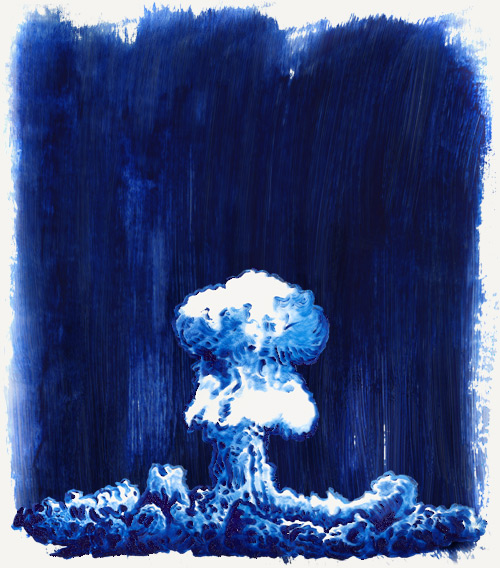Heinrich Diesbach, the German painter and colormaker, was after Cochineal Red Lake, a pigment originally obtained by crushing the bodies of cochineal insects. Toward this end, sometime in 1704, in the laboratory of alchemist Johann Konrad Dippel, Diesbach mixed iron sulphate and carbonate of potash. The potash was contaminated with animal oil, however, and the result was not Cochineal Red. The potash (an alkali) reacted with the animal oil (prepared from blood), to create potassium ferrocyanide. Mixing this with the iron sulphate, created the chemical compound iron ferrocyanide, better known as the first modern synthetic pigment ever created, albeit accidentally: Prussian Blue.
Prior to this discovery a reliable blue pigment was evidently a huge pain in the ass to make, most being rare and expensive or weak and unstable, in as much artists and dyers largely shied away from blue.
Quote: “It’s hard to imagine now, given the range of stable, lightfast colors we can buy, that in the early eighteenth century artists didn’t have an affordable or stable blue to use. Ultramarine, which is extracted from the stone lapis lazuli, was more expensive than vermilion and even gold. (In the Middle Ages, there was only one known source of lapis lazuli, which means simply ‘blue stone’. This was Badakshan, in what is now Afghanistan. Other deposits have subsequently been found in Chile and Siberia). Indigo had a tendency to turn black, was not lightfast, and had a greenish tinge. Azurite turned green when mixed with water so couldn’t be used for frescoes. Smalt was difficult to work with and had a tendency to fade. And not enough was yet known about the chemical properties of copper to consistently create a blue instead of a green.”
In 1842 British astronomer and photographer Sir John Herschel developed a cyanotyping process using Prussian Blue. It was then the only low cost process available for copying drawings. We know the resulting blue prints better as… well… blueprints.
Beyond these matters of interest to brush and pen wielders it seems Prussian Blue is actually an all around fascinating compound “extensively studied by inorganic chemists and solid-state physicists because of its unusual properties.”
For example it is electrochromic, it undergoes intervalence charge transfer, and when treated with acids the tightly bound cyanide groups of its structure can yield the delightful hydrogen cyanide– the colorless, extremely poisonous, and highly volatile liquid that boils slightly above room temperature and, famously, smells of almonds.
Also of interest, in 2006 a couple of Polish chemists were able to construct “logic gates” out of Prussian Blue.
Quote: “Konrad Szacilowski and colleagues at the Jagiellonian University in Krakow have made chemical switches out of titanium dioxide and Prussian blue, which are both commonly used paint pigments. The switches can replicate the basic logical operations in digital circuits. In addition, their behaviour can be altered by shining light on them, allowing direct input of signals from optical fibres.”
What can’t be made into a computer (or a means of digital storage) now-a-days?
Lastly, and somehow the most fascinating to me, is the following fact:
Prussian Blue can remove certain radioactive materials from people’s bodies.
Quote: “Since the 1960s, Prussian blue has been used to treat people who have been internally contaminated with radioactive cesium (mainly Cs-137) and nonradioactive thallium (once an ingredient in rat poisons). Doctors can prescribe Prussian blue at any point after they have determined that a person who is internally contaminated would benefit from treatment. Prussian blue will help speed up the removal of cesium and thallium from the body.”
Or as a 2003 AP story puts it: “The paint pigment Prussian blue could be used to protect citizens from radiation if terrorists stage a so-called “dirty bomb” attack. At present potassium iodide is the only commonly available medication for protection against radiation, although it only helps to protect the thyroid gland from radioactive iodine, and offers no protection to other parts of the body. However, Prussian blue binds to radioactive chemicals in the gut, thus meaning that the radioactivity is eliminated instead of being absorbed by the body. According to the FDA, the pigment reduces the time the body is contaminated after exposure by half.”
Boom!

Er… I mean, Neat!
Course, even with all this historical spice to recommend it, good ol’ Prussian Blue just wasn’t good enough for some people!


